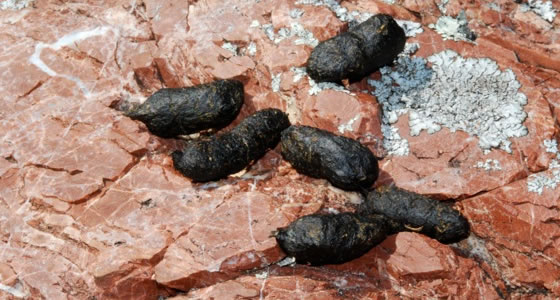How you can help
There are a significant number of Brush-tailed Rock-wallaby sites on private lands. Consequently, responsibility for their welfare rests with private landowners as well as government agencies. One of the most important aspects of Brush-tailed Rock-wallaby survival is the active involvement of local landholders and the community. Landowners and interested people can help by notifying their state parks agency of any Brush-tailed Rock-wallaby sightings.
- If you see signs of Brush-tailed Rock-wallabies when you are out bush-walking or rock-climbing, report this to your state parks agency.
- You are most likely to see Brush-tailed Rock-wallabies in the early morning and evening when they sun themselves on rocky points or ledges.
- A sure sign of the presence of a Brush-tailed Rock-wallaby is a pile of its droppings (scats). These are a distinctive cylindrical shape with a point at one end.
 Brush-tailed Rock-wallaby scats – Photo: Katherine Tuft
Brush-tailed Rock-wallaby scats – Photo: Katherine Tuft - In NSW, you can report sightings via an online species sighting form.
State parks agency contact details are listed on State Information pages: Victoria | New South Wales | Queensland
Further information for…
Landholders
These are some suggestions on what landholders with Brush-tailed Rock-wallaby habitat can do to help save them from extinction.
Volunteers
You can help save the Brush-tailed Rock-wallaby through volunteer work.
Students
Links to further information and stories about the Brush-tailed Rock-wallaby.
State Information
What you can do!
An important aspect of Brush-tailed Rock-wallaby recovery is the active involvement of local landholders and the community overall. See what you can do!
Resources
- Vortex Project Brief
- The Shadow – Newsletter of Brush-tailed Rock-wallaby conservation in Victoria
Did you know?
Brush-tailed Rock-wallabies can climb tall trees with their sharp claws and strong legs. They can also climb almost vertical rocks.






